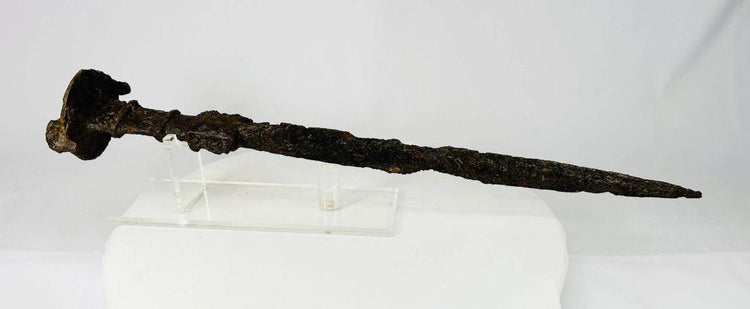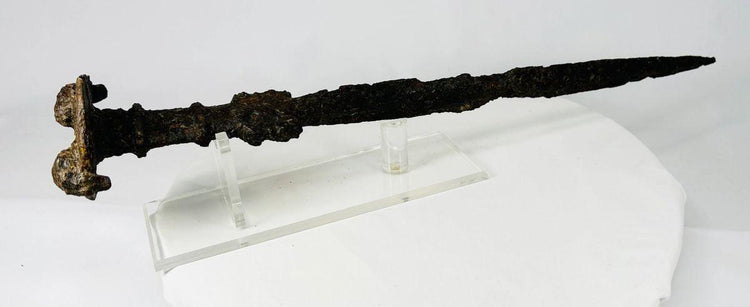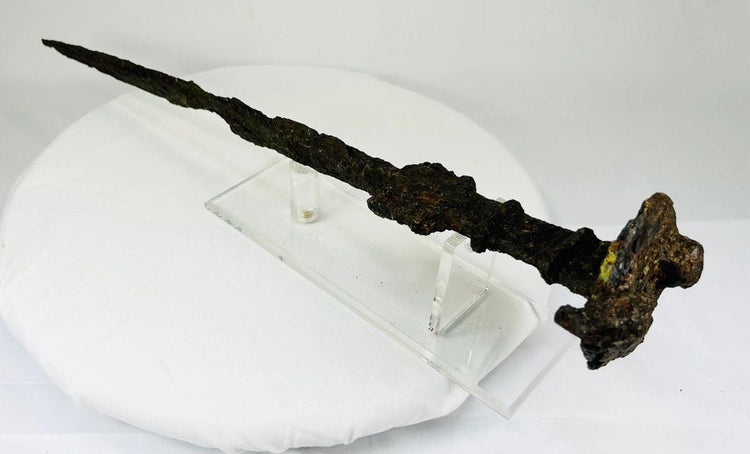Luristan Iron Short Sword | Ancient Near Eastern Weapon | 750–650 BCE
Description
More
Less
Historical Context & Origin
Region: Luristan, Western Iran (Ancient Near East)
Material: Iron
Period: Circa 750–650 BCE (Iron Age)
Description
This Luristan Iron Short Sword (circa 750–650 BCE) exemplifies the Iron Age craftsmanship of ancient Luristan in Western Iran. Measuring approximately 20.5 inches in length, the sword features a lion-head disc pommel, a powerful symbol of strength and protection, complemented by a ribbed grip that combines both functional design and artistic refinement. Despite its ancient origins, this sword retains its original form and proportions, offering a rare glimpse into the martial and ceremonial traditions of the Ancient Near East.
Features
- Lion-head disc pommel symbolizing strength, authority, and divine protection
- Ribbed grip designed for secure handling with aesthetic refinement
- Straight double-edged blade with surviving proportions
- Natural patina and surface oxidization highlighting its ancient age and authenticity
Cultural Significance
During the Iron Age, Luristan was a hub of metallurgical innovation, producing weapons that were both functional and symbolic. Swords such as this were carried by warriors and used in ceremonial settings. The lion motif reflects themes of dominance, divine protection, and social status within Luristan society. This sword connects its bearer to the cultural and martial legacy of one of the Ancient Near East’s most advanced civilizations.
Condition
Good antique condition with surface oxidation and corrosion from centuries of burial. Structurally stable, with all key features—especially the lion-head pommel and ribbed grip—clearly preserved.
Dimensions (approximate)
Length: 20.5 in
Age
Circa 750–650 BCE
Learn More
From Our Blog: The Luristan Iron Short Sword – Legacy of a Warrior
Read More About Luristan Weapons From The University of Argentina: Bronze and iron weapons from Luristan
Explore How They Date These Iron Swords From Cambridge University: Absolute Dating of Early Iron Objects from the Ancient Orient: Radiocarbon Dating of Luristan Iron Swords
Description
Historical Context & Origin
Region: Luristan, Western Iran (Ancient Near East)
Material: Iron
Period: Circa 750–650 BCE (Iron Age)
Description
This Luristan Iron Short Sword (circa 750–650 BCE) exemplifies the Iron Age craftsmanship of ancient Luristan in Western Iran. Measuring approximately 20.5 inches in length, the sword features a lion-head disc pommel, a powerful symbol of strength and protection, complemented by a ribbed grip that combines both functional design and artistic refinement. Despite its ancient origins, this sword retains its original form and proportions, offering a rare glimpse into the martial and ceremonial traditions of the Ancient Near East.
Features
- Lion-head disc pommel symbolizing strength, authority, and divine protection
- Ribbed grip designed for secure handling with aesthetic refinement
- Straight double-edged blade with surviving proportions
- Natural patina and surface oxidization highlighting its ancient age and authenticity
Cultural Significance
During the Iron Age, Luristan was a hub of metallurgical innovation, producing weapons that were both functional and symbolic. Swords such as this were carried by warriors and used in ceremonial settings. The lion motif reflects themes of dominance, divine protection, and social status within Luristan society. This sword connects its bearer to the cultural and martial legacy of one of the Ancient Near East’s most advanced civilizations.
Condition
Good antique condition with surface oxidation and corrosion from centuries of burial. Structurally stable, with all key features—especially the lion-head pommel and ribbed grip—clearly preserved.
Dimensions (approximate)
Length: 20.5 in
Age
Circa 750–650 BCE
Learn More
From Our Blog: The Luristan Iron Short Sword – Legacy of a Warrior
Read More About Luristan Weapons From The University of Argentina: Bronze and iron weapons from Luristan
Explore How They Date These Iron Swords From Cambridge University: Absolute Dating of Early Iron Objects from the Ancient Orient: Radiocarbon Dating of Luristan Iron Swords
You May Also Like






















